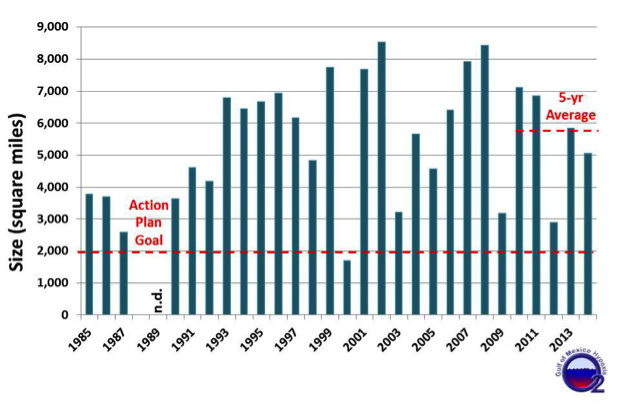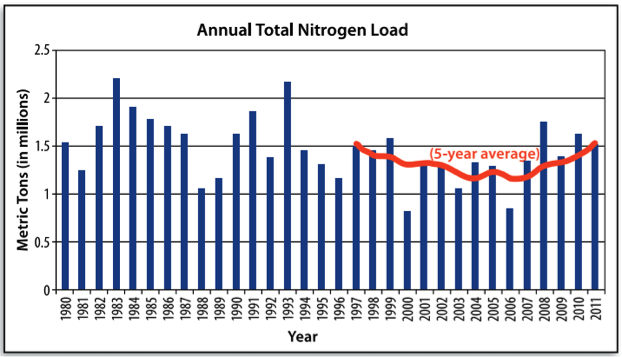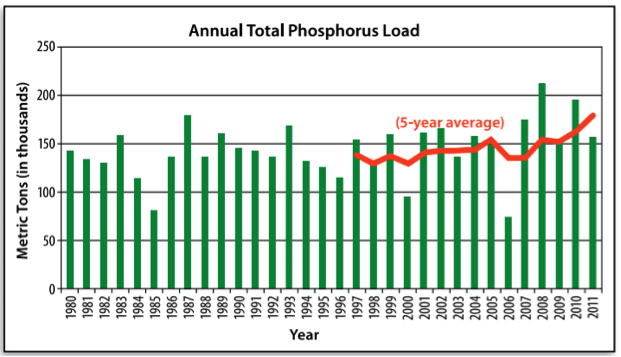5.2.6: Managing Runoff to Reduce the Dead Zone
- Page ID
- 48218
What can be done to reduce the size of the dead zone?
The dead zone in the Gulf of Mexico is primarily a result of runoff of nutrients from fertilizers and manure applied to agricultural land in the Mississippi River basin. Runoff from farms carries nutrients with the water as it drains to the Mississippi River, which ultimately flows to the Gulf of Mexico. If a number of nutrients reaching the Gulf of Mexico can be reduced, then the dead zone will begin the shrink.
Since 2008, the Hypoxia Task Force, led by the U.S. Environmental Protection Agency and consisting of five federal agencies and 12 states, has been working to implement policies and regulations with the aim of reducing the size of the dead zone in the Gulf of Mexico. Many of the strategies for reducing nutrient loading target agricultural practices including (USEPA, The Sources and Solutions: Agriculture).
- Nutrient management: The application of fertilizers can vary in amount, timing, and method with varying impacts on water quality. Better management of nutrient application can reduce nutrient runoff to streams.
- Cover Crops: Planting of certain grasses, grains or clovers, called cover crops can recycle excess nutrients and reduce soil erosion, keeping nutrients out of surface waterways.
- Buffers: Planting trees, shrubs, and grass around fields, especially those that border water bodies, can help by absorbing or filtering out nutrients before they reach a water body.
- Conservation tillage: Reducing how often fields are tilled reduces erosion and soil compaction, builds soil organic matter, and reduces runoff.
- Managing livestock waste: Keeping animals and their waste out of streams, rivers, and lakes keep nitrogen and phosphorus out of the water and restores stream banks.
- Drainage water management: Reducing nutrient loadings that drain from agricultural fields helps prevent degradation of the water in local streams and lakes.
Watch the following video from the US Department of Agriculture about strategies to reduce nutrient loading into the Mississippi River:
Video: Preventing Runoff Into The Mississippi River (1:44)
- Click for a transcript of the Preventing Runoff into the Mississippi River.
-
A US Department of Agriculture initiative is helping Missouri farmers keep farm field runoff from reaching the Mississippi River. USDA's Natural Resources Conservation Service is working with producers through the Mississippi River Basin healthy watersheds initiative, or MRBI. The focus of the MRBI project is to hopefully cut down on sediment, nutrients, and pesticides that are moving down the Mississippi River to the Gulf of Mexico. USDA NRCS and initiative partners are working with farmers to determine which conservation practices and which conservation systems work best on their farms to keep runoff from reaching the Mississippi. What we're trying to do is identify what conservation practices will have the biggest impact in the reduction of nutrient transport to the Mississippi River, which eventually makes it to the Gulf of Mexico. One such conservation practice is terracing. By building the terraces it controls erosion, which then reduce the sediment. By reducing sediment we're also going to be reducing the hypoxia issue in the Gulf. We wanted to then monitor what effects we could have on reductions by putting out monitoring stations, such as this one so we could be able to determine that what benefits we were having with the cost share dollars we were putting on the land. Landowners interested in learning more about how to protect their soil and reduce runoff should contact their local NRCS office. I'm Bob Ellison for the US Department of Agriculture.
EPA website about nutrient pollution and some solutions to nutrient pollution: The Sources and Solutions: Agriculture
Activate Your Learning
Review the graphs below and answer the questions that follow. Figure 4.2.11 presents the size of the hypoxic zone in the Gulf of Mexico from 1985 to 2014. The U.S. Environmental Production Agency led a task force in 2008 that identified a goal to reduce the five-year average of the size of the dead zone to less than 2,000 square miles by 2015.

Figure 4.2.11.: Size of the Gulf of Mexico hypoxic zone in mid-summer. Credit: Data source: Nancy N. Rabalais, LUMCON, and R. Eugene Turner, LSU. Funding sources: NOAA Center for Sponsored Coastal Ocean Research and U.S. EPA Gulf of Mexico Program. From Gulf of Mexico Ecosystems & Hypoxia Assessment (NGOMEX).

Figure 4.2.12.: Annual Total Nitrogen loads to the Gulf of Mexico. Credit: Mississippi River Gulf of Mexico Watershed Nutrient Task Force, 2013.

Figure 4.2.13.: Annual total phosphorus loads to the Gulf of Mexico. Credit: Mississippi River Gulf of Mexico Watershed Nutrient Task Force, 2013.
Knowledge Check (flashcards)
Consider how you would answer the questions on the cards below. Click "Turn" to see the correct answer on the reverse side of each card.
Card 1:
Front: How close have we come to achieving the action plan goal? How many years between 1985 and 2014 had a hypoxic zone smaller than 2,000 square miles (5,000 square kilometers)?
Back: We have not come very close. The 5-year average size of the dead zone from 2010-2014 was about 5,800 square miles and the goal is 2,000 square miles. There was only one year, 2000, between 1985 and 2014 in which the dead zone was smaller than the action plan goal of 2,000 square miles.
Card 2:
Front: Relate the loading of phosphorus and nitrogen to the Gulf of Mexico (Figure 4.2.12 and Figure 4.2.13) to the size of the dead zone. What needs to happen to the annual total nitrogen and phosphorus loading in order to reduce the size of the dead zone?
Back: The annual total nitrogen and phosphorus loading to the Gulf of Mexico has remained high from 1980-2011. In order to reduce the size of the dead zone, the annual nutrient loading needs to decrease. There is a goal to reduce the nutrient loading by 45% of the 1980-1996 baseline average.
Card 3:
Front: Propose some possible strategies that could contribute to a reduction in the size of the hypoxic zone. Whose responsibility do you think it is to strategize for reduction of the size of the hypoxic zone? Whose responsibility is it to regulate and enforce strategies for reduction? Who do you think should pay for the proposed strategies? What are some of the challenges associated with your proposed strategies?
Back: Answers will vary, but should reflect some of the strategies discussed on the EPA website and video linked above, such as cover cropping, buffers, nutrient management.


